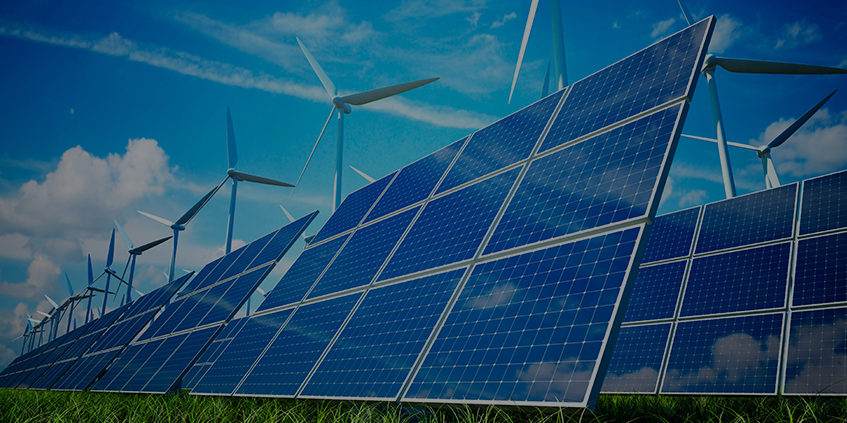Renewable Energy Industry in India
- India stands at 5th position for overall installed renewable energy capacity in the world.
- India is among the top three nations in the world which are leading the global renewable energy growth.
- India has the 4th largest wind power capacity in the world. In December 2019, wind power installed capacity stood at 37.5 GW.
- India has the 5th largest solar power capacity in the world. Solar Energy capacity increased to 33.7 GW in December 2019.
- Biomass power includes installations from biomass combustion, biomass gasification and bagasse co-generation, for which capacity stands at 9.8 GW as of December 2019.
INTRODUCTION
Indian renewable energy sector is the fourth most attractive renewable energy market in the world. India is ranked fourth in wind power, fifth in solar power and fifth in renewable power installed capacity as of 2018.
Installed renewable power generation capacity has gained pace over the past few years, posting a CAGR of 17.33 per cent between FY16–20. With the increased support of Government and improved economics, the sector has become attractive from investors perspective. As India looks to meet its energy demand on its own, which is expected to reach 15,820 TWh by 2040, renewable energy is set to play an important role. As a part of its Paris Agreement commitments, the Government has set an ambitious target of achieving 175 gigawatt (GW) of renewable energy capacity by 2022. These include 100 GW of solar capacity addition and 60 GW of wind power capacity. Government plans to establish renewable energy capacity of 500 GW by 2030.
MARKET SIZE OF RENEWABLE ENERGY INDUSTRY IN INDIA
- Economic growth, increasing prosperity, a growing rate of urbanization and rising per capita energy consumption is contributing to increasing demand for energy in the country.
- The National Solar Mission was launched in 2010. The objective of the mission is to establish India as a global leader in solar energy. The target of National Solar Mission has been up-scaled to 100 GW from 20 GW of grid-connected solar power by 2022.
- India has a wind potential of more than 300 GW (at hub height 100 meters), a solar potential of ~750 GW, assuming 3% wasteland is made available, Small Hydro potential of ~ 20 GW, and a Bio-energy potential of 25 GW.
- As per the Paris Accord on Climate Change, the Government of India has set a target of adding 175 GW of renewable power by 2022, which includes 100 GW from solar, 60 GW from wind, 10 GW from biomass, and 5 GW from small hydropower. This will offer massive investment opportunities across the value chain.
- India aims to achieve 40% of installed power generation capacity from non-fossil fuel sources and reduce the emission intensity of GDP by 33-35 % from 2005 level by 2030. With the accomplishment of these ambitious targets, India will become one of the largest Green Energy producers in the world, surpassing several developed countries.
- India submitted its Intended Nationally Determined Contribution (INDC) to the UNFCCC, on its goal of installing 175 gigawatts (GW) of renewable power capacity by 2022 by setting a new target to increase the country’s share of non-fossil-based installed electric capacity to 40 percent by 2030.
GOVERNMENT INITIATIVES OF RENEWABLE ENERGY INDUSTRY IN INDIA
Some initiatives by the Government of India to boost India’s renewable energy sector are as follows:
- India plans to add 30 GW of renewable energy capacity along a desert on its western border such as Gujarat and Rajasthan.
- Delhi Government decided to shut down thermal power plant in Rajghat and develop it into 5,000 KW solar park
- Rajasthan Government, in Budget 2019-20, exempted solar energy from electricity duty and focussed on the utilization of solar power in its agriculture and public health sectors.
- A new Hydropower policy for 2018-28 was drafted for the growth of hydro projects in the country.
- The Government of India has announced plans to implement a US$ 238 million National Mission on advanced ultra-supercritical technologies for cleaner coal utilisation.
- The Ministry of New and Renewable Energy (MNRE) has decided to provide custom and excise duty benefits to the solar rooftop sector, which will lower the cost of setting up as well as generate power, thus boosting growth.
- Indian Railways is taking increased efforts through sustained energy efficient measures and maximum use of clean fuel to cut down emission level by 33 per cent by 2030.
ROAD AHEAD
The Government of India is committed to increased use of clean energy sources and is already undertaking various large-scale sustainable power projects and promoting green energy heavily. In addition, renewable energy has the potential to create many employment opportunities at all levels, especially in rural areas. The Ministry of New and Renewable Energy (MNRE) has set an ambitious target to set up renewable energy capacities to the tune of 175 GW by 2022 of which about 100 GW is planned for solar, 60 for wind and other for hydro, bio among other. India will need investments of around US$ 125 billion to reach this target.
It is expected that by the year 2040, around 49 percent of the total electricity will be generated by renewable energy, as more efficient batteries will be used to store electricity which will further cut the solar energy cost by 66 percent as compared to the current cost (Capacity from RES is 62.85 GW as of December 2017) Use of renewables in place of coal will save India Rs 54,000 crore (US$ 8.43 billion) annually as per Greenpeace India.
REFERENCES: Media Reports, Press Information Bureau (PIB).
Disclaimer: This information has been collected through a secondary source and ASC is not responsible for any errors in the same.


























































